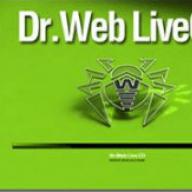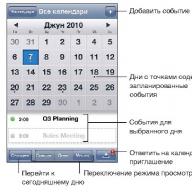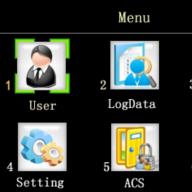Are you wondering how to show hidden folders and files on a Windows 7 computer? Or do you want to know how to show hidden files on a flash drive? In fact, the method works for any drive in the system, no matter whether it is a flash drive, a memory card from a connected camera, or hard drives. I'll show you several ways. For the first method, you do not need any additional programs; everything is done using the Windows system itself.
1. Show hidden files in Explorer
This article gives 4 ways to access the options we need: one through the Control Panel, 2 ways through Explorer itself, and one more through the search bar in Start. All of them are described here consistently and in detail, with screenshots.
So, go to Start -> Control Panel. Its contents open before us, which may differ depending on the chosen viewing method. If browsing is set to Categories (usually it is by default), then you click the link Decor as shown in the picture:
In the next window, select the item Show hidden files and folders.

If viewing is set to Large/Small icons, then click on Folder Options:

A window pops up with various settings for folders. If the window opens on the first tab, then switch to the second tab ( View):


We need to scroll in the Additional parameters window to the end of the list, and there change two parameters: uncheck the item Hide protected system files, and also switch the item in the section Hidden files and folders to position Show hidden files, folders and drives. But when you uncheck the box, you will see a warning. You must select the answer Yes.

After this, all hidden files and folders will come out into the light of day from the depths of the system. They will differ from ordinary ones in a paler color. You can see the result in the picture. Profit!

By the way, there is another way to open the window with parameters without going to the Control Panel. While in any folder in Explorer, click on Arrange at the top left, a menu will drop out, select the item there Folder and search options. A window that is already familiar to us will appear, in which you already know what to do;)

Do you think that's all? No matter how it is! There is another way to bring up the options window;)
Press the Alt key on your keyboard and a menu will appear at the top with the File menu item highlighted. Then use the arrow keys on your keyboard or mouse to go to Tools and click Folder Options...

 aw
aw
Well, is that all for sure now? No, it’s not that simple)) I’ll show you another way to get to the window with parameters. This time through search. Open the Start menu, but we won’t go anywhere further, but start typing the word “settings” (without quotes, of course) into the search bar, as in the picture. In fact, just type the first three or four letters - and you will already see the desired link in the search results at the top:

As you can see, the same result can be achieved in different ways. Choose whichever one you like best. Well, now I will demonstrate a way to show hidden files in total.
2. Show hidden files in Total Commander
If you have Total Commander installed, you can enable the display of hidden files and folders in the settings. There are different assemblies of the total, the appearance may differ from mine, but most likely this will not bother you. So, let's go to the settings:

In the Panel Contents section, I checked the Show hidden/system files checkbox. Then click OK and you're done, hidden files are now displayed.

Unlike Explorer, the color of folders does not fade, and a red exclamation mark on the folder or file icon allows you to distinguish a hidden folder/file from a regular one.
One last piece of advice: in the system itself, in Explorer, return the settings for hidden files to their original state after you finish solving the task for which you needed to display them. There is no particular need to keep hidden files in plain sight at all times.
Did the article help you? Write, leave comments. Can you find another method not described above?)
I think many users of the Windows operating system are familiar with the Total Commander file manager, but they still have questions about using this file manager, such as: how to hide files in Total Commander, how to view hidden files in Total Commander. We'll look at some in this article.
Total Commander is a popular file manager that allows you to work with your file system in two windows. With Total Commander you can copy, move, delete files, change their attributes and much more.
You can download Total Commander from the official website. You also have the opportunity to use the portable version of the Total Commander Portable file manager in order to always have it at hand, for example on an external drive.
How to view hidden files in Total Commander
To enable the display of hidden files in Total Commander, go to the tab Configuration -> Settings and in the window that opens, go to the section Panel Contents, here you actually need to check the box Show hidden files. Also, if necessary, you can enable the display of system files.
To hide hidden files in Total Commander, you just need to uncheck the previously checked box Show hidden files.
For users of the English version of the Total Commander file manager, you need to go to Configuration -> Options -> Display -> show hidden/ system files.
How to hide files in Total Commander
In order to hide files in Total Commander, you can use the tools of the Windows operating system or the tools of Total Commander. You can see how to hide files and folders in Windows in the article How to enable hidden folders in Windows 10.
To hide files using the file manager, select the desired folder or file and open the menu File -> Edit Attributes.
In the window that opens, check the attribute hidden to make a file or folder hidden. You also have the opportunity to set other attributes in this window.
A good feature of the Total Commander file manager is its excellent file search. With which you can search not only files, but also text in text files. Therefore, searching for total commander files is much more effective than standard Windows search.
In this article, we looked at how to hide files and folders in Total Commander 9.0a and actually how to hide files and folders using this file manager. On previous versions of Total Commander, displaying hidden files is enabled in the same way. I hope the article was interesting and useful for you.
Good day.
On the disk, in addition to “regular” files, there are also hidden and system files, which (as conceived by Windows developers) should be invisible to novice users.
But sometimes you need to put things in order among such files, and to do this you need to see them first. In addition, any folders and files can be made hidden by setting the appropriate attributes in the properties.
In this article (mainly for novice users) I want to show several ways to easily and quickly see hidden files. In addition, by using the programs listed in the article, you will be able to catalog and organize your files well.
Method No. 1: Configuring the Explorer
This method is suitable for those who do not want to install anything. To see hidden files in Explorer, you just need to make a few settings. Let's look at the example of Windows 8 (in Windows 7 and 10 it is done similarly).
First you need to open the control panel and go to the " Design and personalization" (see Fig. 1).

In the folder options, scroll the list of options to the end, at the very bottom put the switch on the item " Show hidden files, folders and drives" (see Fig. 3). Save the settings and open the desired drive or folder: all hidden files should be visible (with the exception of system files, to display them, you need to uncheck the corresponding item in the same menu, see Fig. 3) .

Method No. 2: installation and configuration of ACDSee
Official website: http://www.acdsee.com/

One of the most famous programs for viewing pictures, and multimedia files in general. In addition, the latest versions of the program allow you not only to conveniently view graphic files, but also to work with folders, videos, archives (by the way, archives can generally be viewed without extracting them!) and in general, with any files.
Total Commander
Official website: http://wincmd.ru/
I couldn't ignore this program. In my opinion, this is one of the best tools for working with folders and files, much more convenient than the built-in Explorer in Windows.
Main advantages (in my opinion):
- - works an order of magnitude faster than conductor;
- - allows you to view archives as if they were regular folders;
- - does not slow down when opening folders with a large number of files;
- - huge functionality and capabilities;
- - all options and settings are conveniently at hand.
To see hidden files, simply click on the exclamation mark icon in the program panel.
Searching for hidden files and folders on a computer is the prerogative of experienced users, however, it is sometimes useful for beginners to find out what Windows hides in the depths of its file system. I must say, there are objects that are not displayed even if you configure it to display hidden folders and files.
Most often, this is exactly what malware does, disguising its executable files as hidden objects in the file system. A new program called Hidden File Finder will help you figure out where is friend and where is foe. The main purpose of this utility is to display hidden content, as well as check it using a well-known service.
You can download CHidden File Finder on the developer’s website. The utility is free, lightweight and has an unusually high speed. During installation, it will try to push through a couple of panels, so be careful, refuse gifts by clicking Decline in the installer wizard window. Hidden File Finder has a catchy and at the same time simple-looking interface.
There is no Russian language, but by and large it is not needed there, everything should be clear without words. The user is asked to select the area to be scanned and click the Start Scan button, and after a few moments a list of all found hidden objects will be generated.

In this case, the program displays the object name, type (file or folder), size, creation date and full path. To make it easier to identify items, Hidden File Finder uses a color scheme. Thus, directories are marked in blue, executable files, including libraries, are marked in red, all other hidden elements are marked in black - logs, database files, as well as files that do not have an extension.
Right-clicking on the selected list item opens. Among the available commands, we note deletion, going to a folder, searching for information on Google, sending for verification to VirusTotal. There is also an option that allows you to make a file or folder visible, that is, exclude it from the list of hidden objects in the file system. Objects transferred to the category available for viewing in Explorer are marked in green by the program.
Everything would be fine, but it remains unclear, by what signs should the user guess that this particular file is suspicious? There can be several thousand “red” files, how can you identify a potentially dangerous one among them? Viruses' preference for saving to a known folder is partly a clue, but the virus can just as easily copy itself anywhere
Description of the problem
When opening a flash drive, folders, files and other elements are not displayed.
Cause
The work of a malicious application that has changed the attributes of elements to a hidden display mode.
Options for solving the problem
Select "Folder Options" (for Windows 7 and higher - "Folder Options").

Go to the “View” tab. Here you need to uncheck “Hide protected system files” and check next to “Show hidden files, folders, drives”. Then click “OK”.

Open “My Computer”. Right-click on the flash drive icon and select “Properties”.
![]()
A window will appear in which you need to uncheck the “Hide” command.
2. You can also access hidden files on a flash drive using the Total Commander program.
Let's launch the software. Select “Configuration” on the toolbar. Here click “Settings”.

Go to the “Panel Contents” tab, which is located on the left side of the working window and check the “Show hidden/system files” checkbox.
The contents of the disk drive will be displayed.

3. The third method can be called “Medicine for a flash drive.”
Open the removable disk. Right-click and select “Create”, “Text Document” (Notepad type).

We give the document a name. For example, “Doctor for a flash drive.”

We write in the text the following command “attrib -s -h -r -a *.* /s /d”

Save the file.


Go to the “View” tab and uncheck “Hide extension for known file types”.

Let's return to the flash drive. Click “Rename” and place the format “txt”, enter “.bat”. The result is a program file.

We run the file and all the elements on the flash drive are displayed.
In order for the computer to start showing hidden files and folders, you need to enable showing hidden folders in the folder settings, or you can simply view hidden folders in Total Commander. Let's take a closer look at both options.
How to make hidden folders visible in Windows 8
To make a folder visible, you need to open the folder options, and to do this, open “Control Panel” - “Appearance and Personalization” - “Folder Options”. In the “Folder Options” window that opens, go to the “View” tab.
If you hide the folder, how to get it back is shown
We look at “Advanced options” at the very bottom there is an item “Hide files and folders”, open it and put a dot at the option “Show files, folders and drives” and then click the “OK” button. This is the first way to see hidden folders in Windows.
How to View Hidden Folders in Total Commander
To detect hidden folders in Windows 8, you need to know how to configure the display of hidden folders in Total Commander. First, launch Total Commander, if you don’t have it, then you need it. Then in Total Commander click “Configuration” and select “Settings”.
 Hidden files and folders can be seen in Total Commander
Hidden files and folders can be seen in Total Commander In the “Settings” window, click on the item “Contents of panels” in the left column and in the right column, check the box next to “Show hidden/system files” and click “OK”. Now we will see all hidden folders. Now you know how to configure Total Commander to display hidden files and folders on your computer and other media.
Sometimes it may happen that some kind of virus has hidden folders on a flash drive. What to do if a virus has hidden folders can be found in the article
Many people install Total Commander in order to simplify “communication” with the computer, speed up work on it, and to better learn how to use the file system. If you install Total specifically for such purposes, then you are doing the right thing, because this is a wonderful decision - the program will quickly become your right hand and over time you will understand how slow all other users are who have not installed a file manager on their computer.
But not everyone knows that Total Commander can be used for all sorts of tricks.
This program is a complete “life hack”, because it allows you to quickly and easily do something that in another situation would take up hours of your precious time.
For example, you can find text files by pieces of text in a matter of seconds using smart search in Total. But what’s even more interesting is that you can find something on your computer that you never noticed before—hidden folders and files! Most likely, you now think that you don’t have them on your computer, but once you turn on Total Commander, you will realize that they are, and you have a lot of them!
How to find hidden files and folders using Total Commander
First, it’s worth looking at why you need all sorts of hidden folders and files on your computer. Don't think that inside them you will find treasure maps and some precious files that will reveal to you the secret of success. This will not happen, but it is likely that hidden files, and especially folders, contain something that harms your computer system. There are many examples when, using the Total Commander program, users found all sorts of viruses and malware on their computer.
Recently, virus developers have become even more cunning. They inject viruses onto your computer using other applications. You could install the same Total Commander on your computer, downloaded from an unverified site, and within a week your PC begins to swarm with “pop-ups” and other intrusive types of advertising. Suspecting that you downloaded the virus along with the program archive, you begin to look for strange folders on your computer. But to your surprise, you don’t find any. And all because the developers placed hidden folders and files in the archive that quietly harm your computer and you, including, by showing obscene advertisements.
In addition, many programs that you have installed on your computer contain various configuration files. So that you don’t accidentally edit them, thereby ruining the work of the program, they hide them in folders. But it happens that if you uninstall a program incorrectly, these configuration files remain on your computer. As a result, the folder seems to be empty, but in “Properties” it is written that it has a certain weight. Only by using the Total Commander program can you make these files visible. Let's figure out how this can be done.
So, go to Total Commander. Two panels will open in front of you. They are needed to make it convenient to work with media and different folders or disks. Select one of the panels. After that, you need to open the settings to enable viewing of hidden files and folders. Click on the “Configuration” menu item. After that, go to Settings and Display menu. In this section, you will see a line that will allow you to show hidden data in the file system. Click the checkbox next to this item - it will say something like “Show hidden files/folders”. Save the settings and go to the panels.
That's all you had to do. Now, when you view the contents of drives and folders, you will see all the hidden data that is in them. So in a couple of minutes, through the Total file manager, you can see something that was not on your computer before! Perhaps you will find something interesting.






